Managing Financial Resources Solved Assignment
VerifiedAdded on 2021/02/18
|11
|2910
|16
AI Summary
Contribute Materials
Your contribution can guide someone’s learning journey. Share your
documents today.
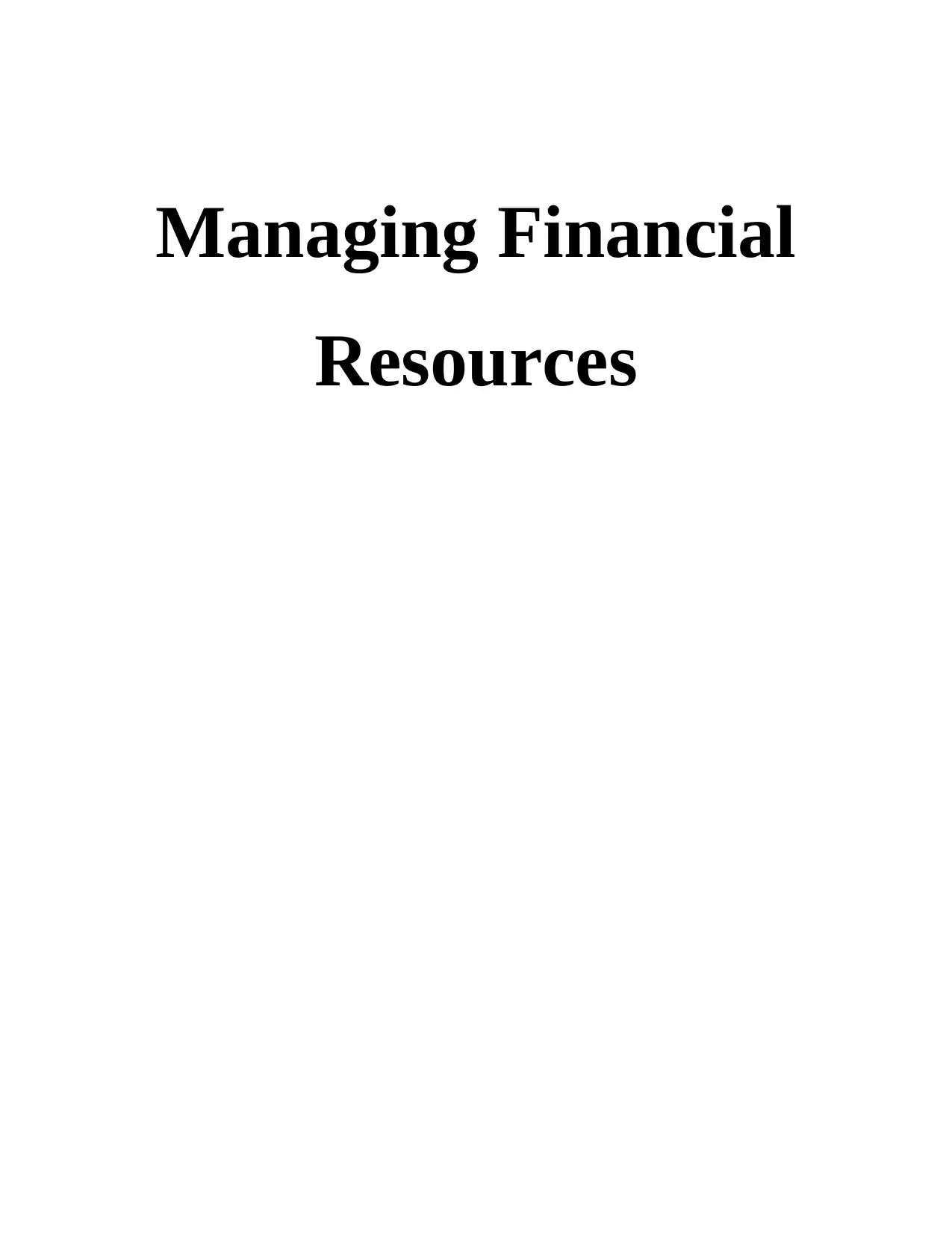
Managing Financial
Resources
Resources
Secure Best Marks with AI Grader
Need help grading? Try our AI Grader for instant feedback on your assignments.
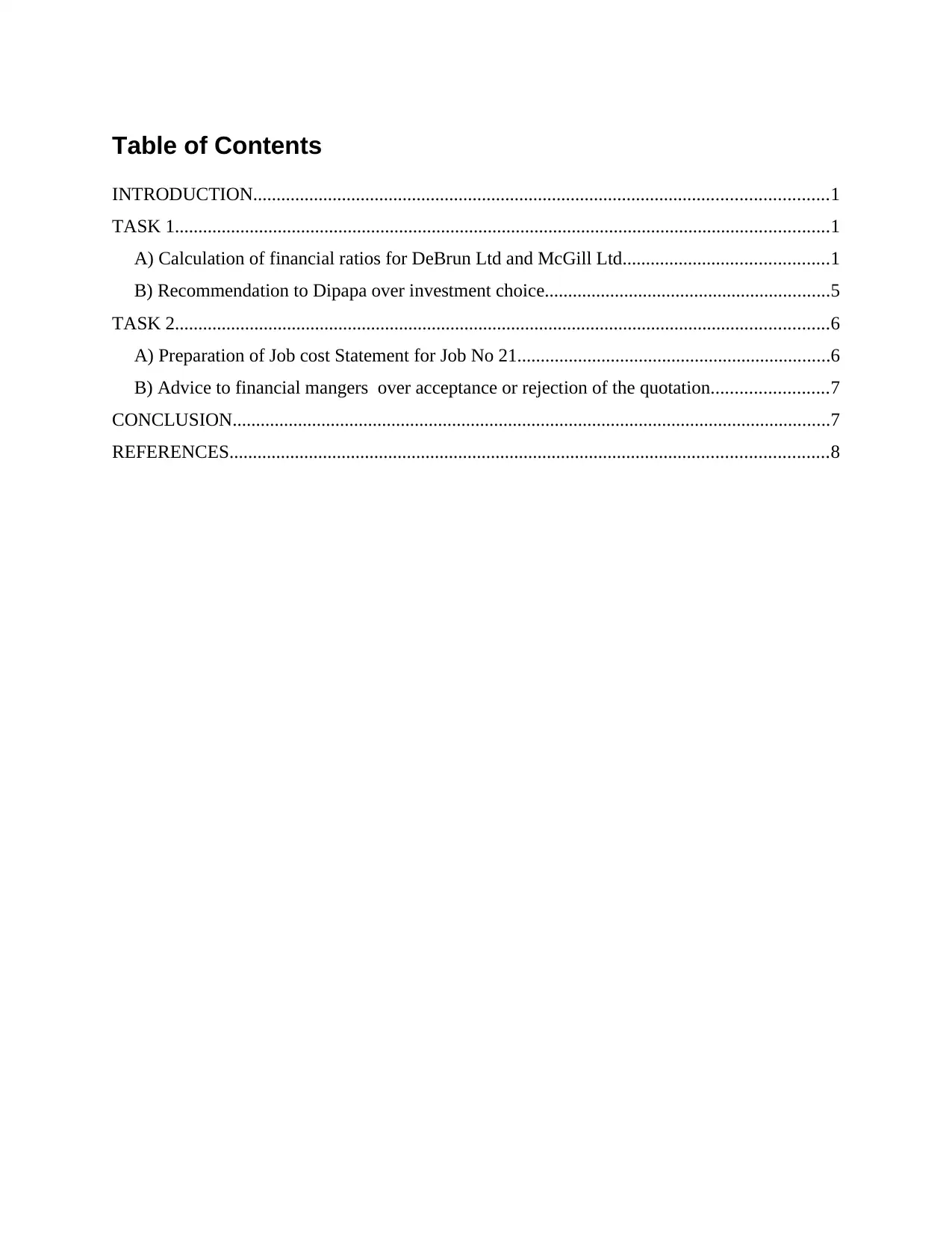
Table of Contents
INTRODUCTION...........................................................................................................................1
TASK 1............................................................................................................................................1
A) Calculation of financial ratios for DeBrun Ltd and McGill Ltd............................................1
B) Recommendation to Dipapa over investment choice.............................................................5
TASK 2............................................................................................................................................6
A) Preparation of Job cost Statement for Job No 21...................................................................6
B) Advice to financial mangers over acceptance or rejection of the quotation.........................7
CONCLUSION................................................................................................................................7
REFERENCES................................................................................................................................8
INTRODUCTION...........................................................................................................................1
TASK 1............................................................................................................................................1
A) Calculation of financial ratios for DeBrun Ltd and McGill Ltd............................................1
B) Recommendation to Dipapa over investment choice.............................................................5
TASK 2............................................................................................................................................6
A) Preparation of Job cost Statement for Job No 21...................................................................6
B) Advice to financial mangers over acceptance or rejection of the quotation.........................7
CONCLUSION................................................................................................................................7
REFERENCES................................................................................................................................8
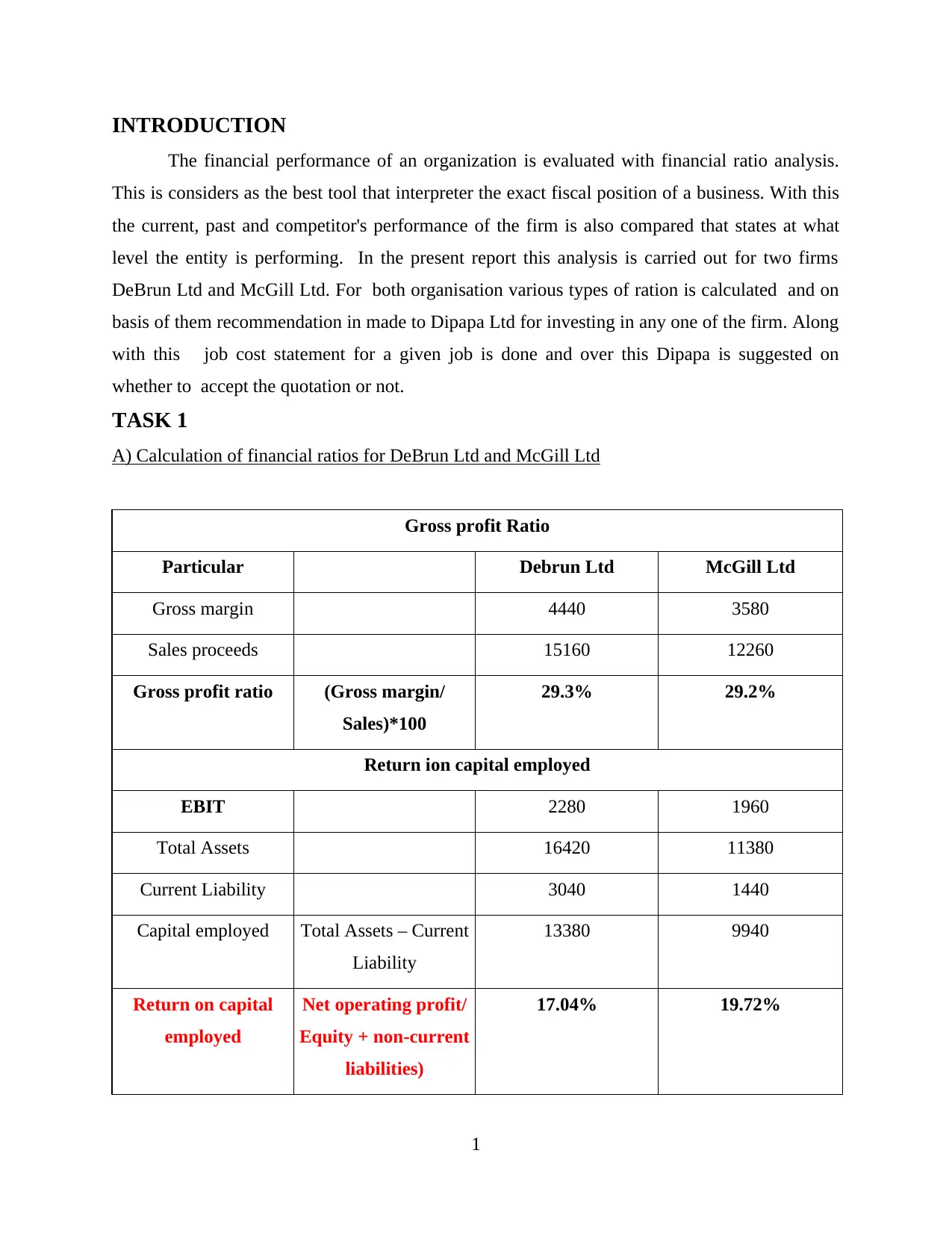
INTRODUCTION
The financial performance of an organization is evaluated with financial ratio analysis.
This is considers as the best tool that interpreter the exact fiscal position of a business. With this
the current, past and competitor's performance of the firm is also compared that states at what
level the entity is performing. In the present report this analysis is carried out for two firms
DeBrun Ltd and McGill Ltd. For both organisation various types of ration is calculated and on
basis of them recommendation in made to Dipapa Ltd for investing in any one of the firm. Along
with this job cost statement for a given job is done and over this Dipapa is suggested on
whether to accept the quotation or not.
TASK 1
A) Calculation of financial ratios for DeBrun Ltd and McGill Ltd
Gross profit Ratio
Particular Debrun Ltd McGill Ltd
Gross margin 4440 3580
Sales proceeds 15160 12260
Gross profit ratio (Gross margin/
Sales)*100
29.3% 29.2%
Return ion capital employed
EBIT 2280 1960
Total Assets 16420 11380
Current Liability 3040 1440
Capital employed Total Assets – Current
Liability
13380 9940
Return on capital
employed
Net operating profit/
Equity + non-current
liabilities)
17.04% 19.72%
1
The financial performance of an organization is evaluated with financial ratio analysis.
This is considers as the best tool that interpreter the exact fiscal position of a business. With this
the current, past and competitor's performance of the firm is also compared that states at what
level the entity is performing. In the present report this analysis is carried out for two firms
DeBrun Ltd and McGill Ltd. For both organisation various types of ration is calculated and on
basis of them recommendation in made to Dipapa Ltd for investing in any one of the firm. Along
with this job cost statement for a given job is done and over this Dipapa is suggested on
whether to accept the quotation or not.
TASK 1
A) Calculation of financial ratios for DeBrun Ltd and McGill Ltd
Gross profit Ratio
Particular Debrun Ltd McGill Ltd
Gross margin 4440 3580
Sales proceeds 15160 12260
Gross profit ratio (Gross margin/
Sales)*100
29.3% 29.2%
Return ion capital employed
EBIT 2280 1960
Total Assets 16420 11380
Current Liability 3040 1440
Capital employed Total Assets – Current
Liability
13380 9940
Return on capital
employed
Net operating profit/
Equity + non-current
liabilities)
17.04% 19.72%
1
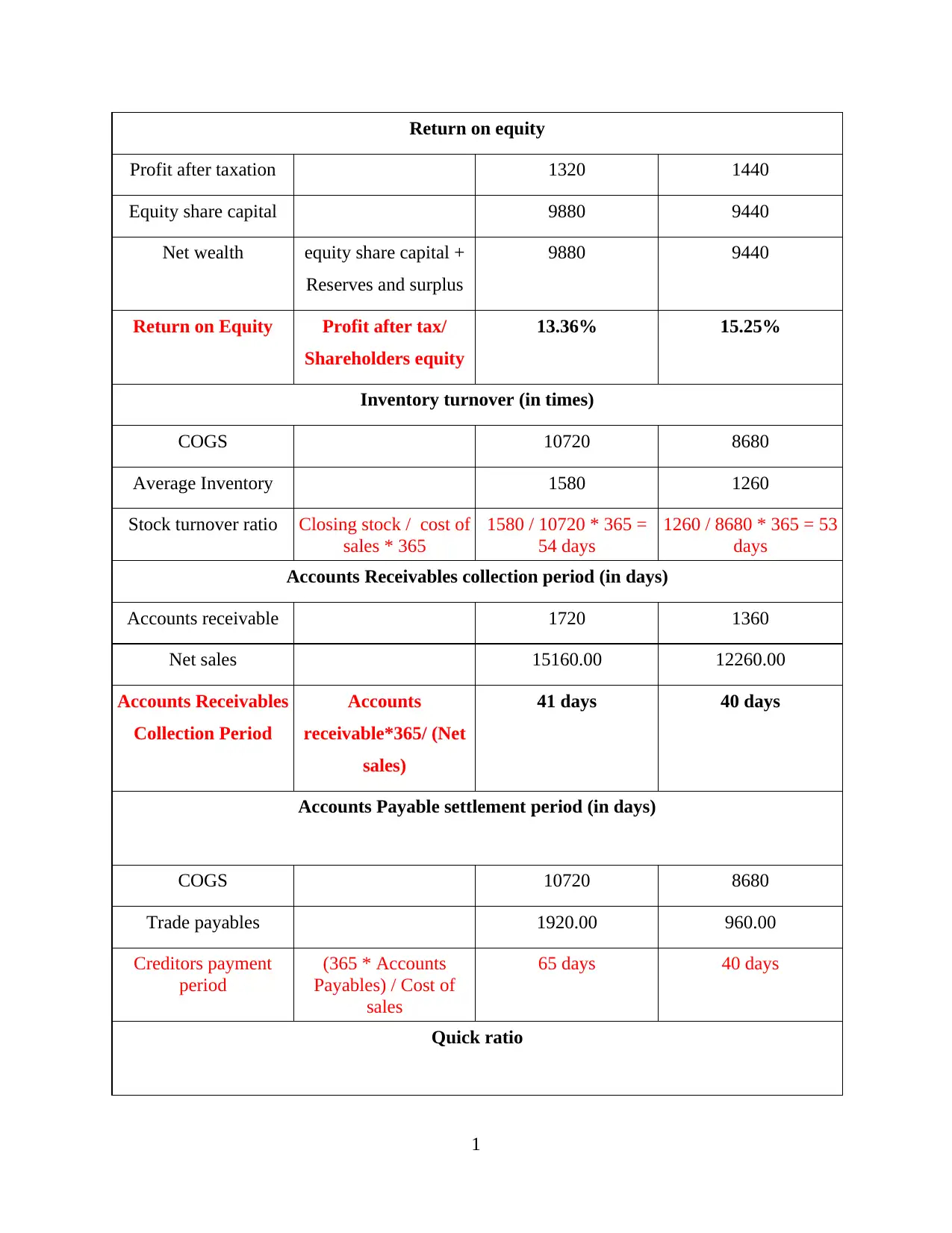
Return on equity
Profit after taxation 1320 1440
Equity share capital 9880 9440
Net wealth equity share capital +
Reserves and surplus
9880 9440
Return on Equity Profit after tax/
Shareholders equity
13.36% 15.25%
Inventory turnover (in times)
COGS 10720 8680
Average Inventory 1580 1260
Stock turnover ratio Closing stock / cost of
sales * 365
1580 / 10720 * 365 =
54 days
1260 / 8680 * 365 = 53
days
Accounts Receivables collection period (in days)
Accounts receivable 1720 1360
Net sales 15160.00 12260.00
Accounts Receivables
Collection Period
Accounts
receivable*365/ (Net
sales)
41 days 40 days
Accounts Payable settlement period (in days)
COGS 10720 8680
Trade payables 1920.00 960.00
Creditors payment
period
(365 * Accounts
Payables) / Cost of
sales
65 days 40 days
Quick ratio
1
Profit after taxation 1320 1440
Equity share capital 9880 9440
Net wealth equity share capital +
Reserves and surplus
9880 9440
Return on Equity Profit after tax/
Shareholders equity
13.36% 15.25%
Inventory turnover (in times)
COGS 10720 8680
Average Inventory 1580 1260
Stock turnover ratio Closing stock / cost of
sales * 365
1580 / 10720 * 365 =
54 days
1260 / 8680 * 365 = 53
days
Accounts Receivables collection period (in days)
Accounts receivable 1720 1360
Net sales 15160.00 12260.00
Accounts Receivables
Collection Period
Accounts
receivable*365/ (Net
sales)
41 days 40 days
Accounts Payable settlement period (in days)
COGS 10720 8680
Trade payables 1920.00 960.00
Creditors payment
period
(365 * Accounts
Payables) / Cost of
sales
65 days 40 days
Quick ratio
1
Secure Best Marks with AI Grader
Need help grading? Try our AI Grader for instant feedback on your assignments.
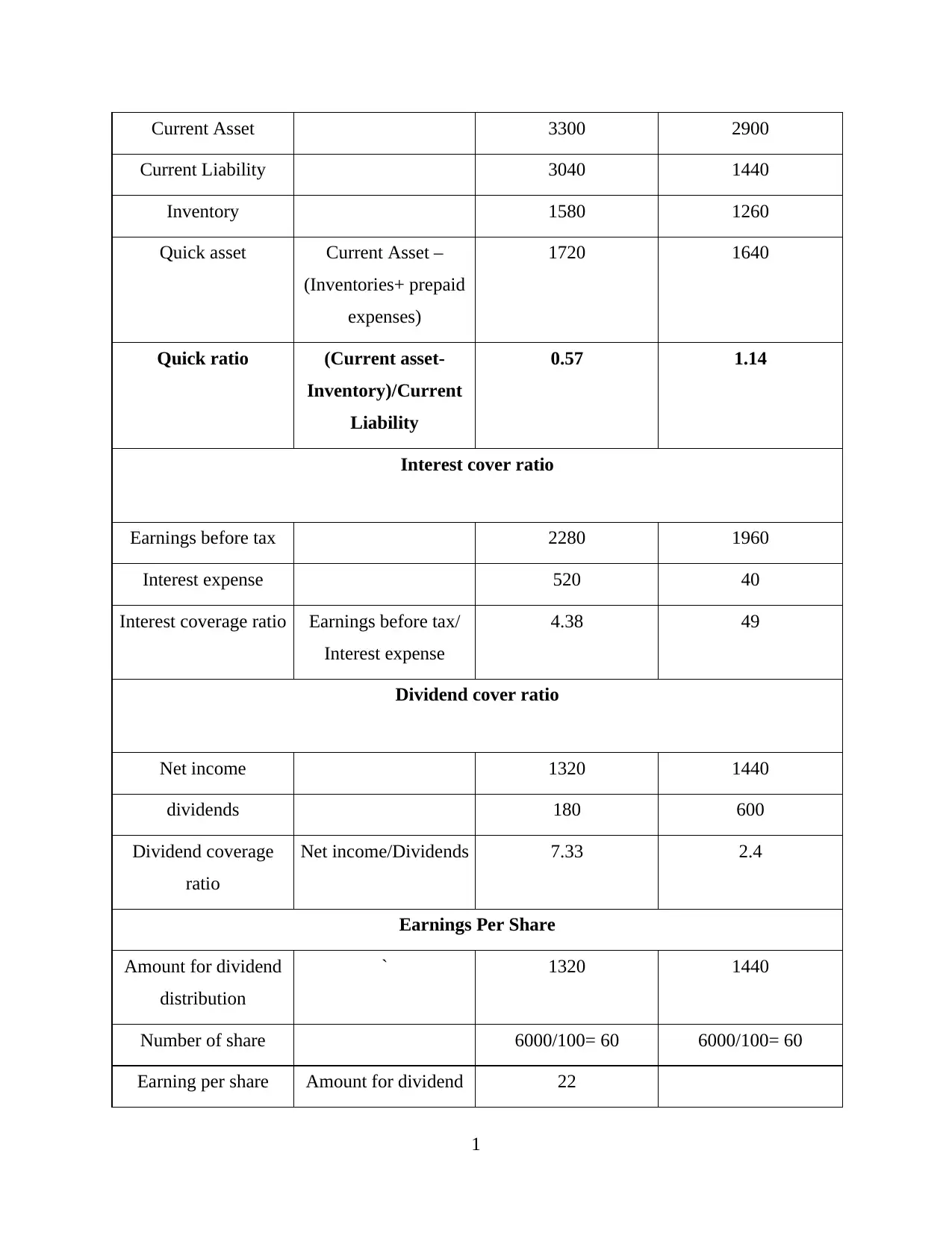
Current Asset 3300 2900
Current Liability 3040 1440
Inventory 1580 1260
Quick asset Current Asset –
(Inventories+ prepaid
expenses)
1720 1640
Quick ratio (Current asset-
Inventory)/Current
Liability
0.57 1.14
Interest cover ratio
Earnings before tax 2280 1960
Interest expense 520 40
Interest coverage ratio Earnings before tax/
Interest expense
4.38 49
Dividend cover ratio
Net income 1320 1440
dividends 180 600
Dividend coverage
ratio
Net income/Dividends 7.33 2.4
Earnings Per Share
Amount for dividend
distribution
` 1320 1440
Number of share 6000/100= 60 6000/100= 60
Earning per share Amount for dividend 22
1
Current Liability 3040 1440
Inventory 1580 1260
Quick asset Current Asset –
(Inventories+ prepaid
expenses)
1720 1640
Quick ratio (Current asset-
Inventory)/Current
Liability
0.57 1.14
Interest cover ratio
Earnings before tax 2280 1960
Interest expense 520 40
Interest coverage ratio Earnings before tax/
Interest expense
4.38 49
Dividend cover ratio
Net income 1320 1440
dividends 180 600
Dividend coverage
ratio
Net income/Dividends 7.33 2.4
Earnings Per Share
Amount for dividend
distribution
` 1320 1440
Number of share 6000/100= 60 6000/100= 60
Earning per share Amount for dividend 22
1
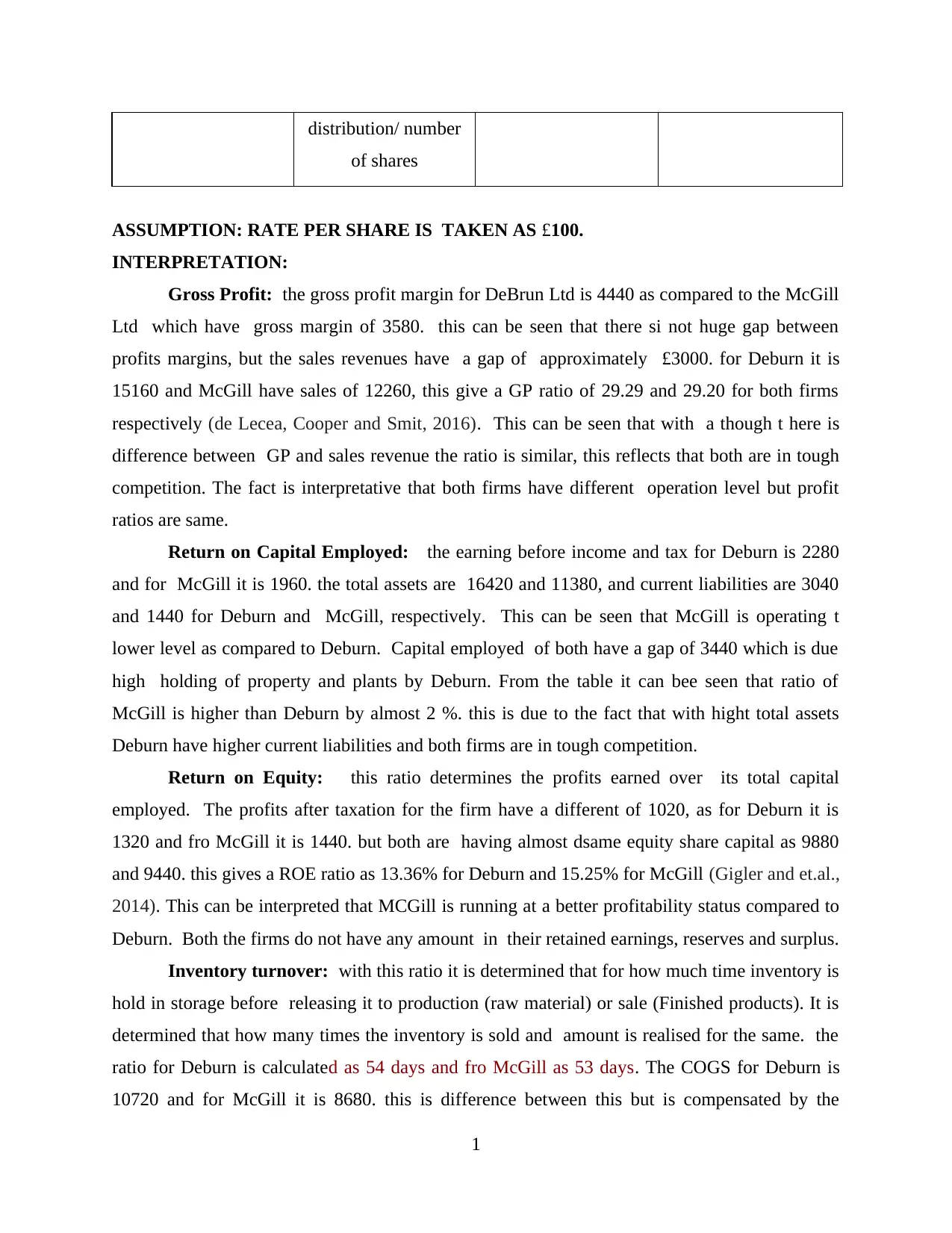
distribution/ number
of shares
ASSUMPTION: RATE PER SHARE IS TAKEN AS £100.
INTERPRETATION:
Gross Profit: the gross profit margin for DeBrun Ltd is 4440 as compared to the McGill
Ltd which have gross margin of 3580. this can be seen that there si not huge gap between
profits margins, but the sales revenues have a gap of approximately £3000. for Deburn it is
15160 and McGill have sales of 12260, this give a GP ratio of 29.29 and 29.20 for both firms
respectively (de Lecea, Cooper and Smit, 2016). This can be seen that with a though t here is
difference between GP and sales revenue the ratio is similar, this reflects that both are in tough
competition. The fact is interpretative that both firms have different operation level but profit
ratios are same.
Return on Capital Employed: the earning before income and tax for Deburn is 2280
and for McGill it is 1960. the total assets are 16420 and 11380, and current liabilities are 3040
and 1440 for Deburn and McGill, respectively. This can be seen that McGill is operating t
lower level as compared to Deburn. Capital employed of both have a gap of 3440 which is due
high holding of property and plants by Deburn. From the table it can bee seen that ratio of
McGill is higher than Deburn by almost 2 %. this is due to the fact that with hight total assets
Deburn have higher current liabilities and both firms are in tough competition.
Return on Equity: this ratio determines the profits earned over its total capital
employed. The profits after taxation for the firm have a different of 1020, as for Deburn it is
1320 and fro McGill it is 1440. but both are having almost dsame equity share capital as 9880
and 9440. this gives a ROE ratio as 13.36% for Deburn and 15.25% for McGill (Gigler and et.al.,
2014). This can be interpreted that MCGill is running at a better profitability status compared to
Deburn. Both the firms do not have any amount in their retained earnings, reserves and surplus.
Inventory turnover: with this ratio it is determined that for how much time inventory is
hold in storage before releasing it to production (raw material) or sale (Finished products). It is
determined that how many times the inventory is sold and amount is realised for the same. the
ratio for Deburn is calculated as 54 days and fro McGill as 53 days. The COGS for Deburn is
10720 and for McGill it is 8680. this is difference between this but is compensated by the
1
of shares
ASSUMPTION: RATE PER SHARE IS TAKEN AS £100.
INTERPRETATION:
Gross Profit: the gross profit margin for DeBrun Ltd is 4440 as compared to the McGill
Ltd which have gross margin of 3580. this can be seen that there si not huge gap between
profits margins, but the sales revenues have a gap of approximately £3000. for Deburn it is
15160 and McGill have sales of 12260, this give a GP ratio of 29.29 and 29.20 for both firms
respectively (de Lecea, Cooper and Smit, 2016). This can be seen that with a though t here is
difference between GP and sales revenue the ratio is similar, this reflects that both are in tough
competition. The fact is interpretative that both firms have different operation level but profit
ratios are same.
Return on Capital Employed: the earning before income and tax for Deburn is 2280
and for McGill it is 1960. the total assets are 16420 and 11380, and current liabilities are 3040
and 1440 for Deburn and McGill, respectively. This can be seen that McGill is operating t
lower level as compared to Deburn. Capital employed of both have a gap of 3440 which is due
high holding of property and plants by Deburn. From the table it can bee seen that ratio of
McGill is higher than Deburn by almost 2 %. this is due to the fact that with hight total assets
Deburn have higher current liabilities and both firms are in tough competition.
Return on Equity: this ratio determines the profits earned over its total capital
employed. The profits after taxation for the firm have a different of 1020, as for Deburn it is
1320 and fro McGill it is 1440. but both are having almost dsame equity share capital as 9880
and 9440. this gives a ROE ratio as 13.36% for Deburn and 15.25% for McGill (Gigler and et.al.,
2014). This can be interpreted that MCGill is running at a better profitability status compared to
Deburn. Both the firms do not have any amount in their retained earnings, reserves and surplus.
Inventory turnover: with this ratio it is determined that for how much time inventory is
hold in storage before releasing it to production (raw material) or sale (Finished products). It is
determined that how many times the inventory is sold and amount is realised for the same. the
ratio for Deburn is calculated as 54 days and fro McGill as 53 days. The COGS for Deburn is
10720 and for McGill it is 8680. this is difference between this but is compensated by the
1

variation in average inventory hold by the firms i.e. 1580 and 1260. with this the ration comes
same and it is articulated that both are in tough competition.
Accounts Receivables Collection Period: this ratio determines the time taken by the as
firm to realise the amount of sales made to debtors. The more times given to debtors the more
the liquidity is affected as the amount gets blocked with debtor (Ward, 2017). With lesser time
taken by debtors the working capital requirement of organisation is not hampered. This ratio of
Mc Gill is 40.49 and for Deburn is 41.41. this can be interpreted that the debtors of McGill takes
1 day for receiving payment from debtors on products purchased by them.
Accounts Payable settlement period: this ratio defines the time taken by an
organisation to make payment to its suppliers and creditors. The more time given the taken to
repay the lesser impact on liquidity and availability of the working capital (Ortea and Gallardo,
2015). Debrun tasks 65 days to make payment to its vendors while McGill takes 40 days. With
this is can be articulated that Debrun takes extra time to make payment to its suppliers. Referring
this, it can be stated that management of McGil is good in terms of settlement with creditors.
Quick ratio:This is a liquidity ratio which determines the position of an organisation to
meet its immediate current liabilities. The higher the ratio the more liquidity a firm owes. The
ideal ratio in the industry is 1:1.For McGill it is 1.14 and for Deburn 0.57. this can be seen from
the above table that MC gills have lower current liabilities as compared to Deburn and this is the
reason that it have a ratio over optimal ratio, thought the quick ration of Deburn is higher yet the
ratio is lower as it have more current liabilities in its balance sheet.
Interest cover ratio: this ratio defines the profits earned by an organisation to cover the
interest expenses on loans and mortgages taken by firm. The higher the ratio the better the
position of the business meet its interest expenses. The interest expenses are covered from EBIT
and fro MC Gill it is calculated as 49 and for Deburn as 4.38 (Petruzzo, and et.al., 2015). there
is vast gap in the ratio. This is due to the variation in capital structure both the firm. McGill
have lesser amount of debt and this results in lesser interest cost for the firm. Though De burn
have higher EBIT but with a very high amount of interest the ratio comes very low. This reflects
that Debrum have lesser interest payment ability as compared to McGill.
Dividend cover ratio: this reflects ability of an organisation to cover the dividend
expenses form its final profits after tax and interest. This shows the ability opf the firm to pays
its shareholders the shares owned by them. For Deburn it is calculated as 7.33 and for McGill as
1
same and it is articulated that both are in tough competition.
Accounts Receivables Collection Period: this ratio determines the time taken by the as
firm to realise the amount of sales made to debtors. The more times given to debtors the more
the liquidity is affected as the amount gets blocked with debtor (Ward, 2017). With lesser time
taken by debtors the working capital requirement of organisation is not hampered. This ratio of
Mc Gill is 40.49 and for Deburn is 41.41. this can be interpreted that the debtors of McGill takes
1 day for receiving payment from debtors on products purchased by them.
Accounts Payable settlement period: this ratio defines the time taken by an
organisation to make payment to its suppliers and creditors. The more time given the taken to
repay the lesser impact on liquidity and availability of the working capital (Ortea and Gallardo,
2015). Debrun tasks 65 days to make payment to its vendors while McGill takes 40 days. With
this is can be articulated that Debrun takes extra time to make payment to its suppliers. Referring
this, it can be stated that management of McGil is good in terms of settlement with creditors.
Quick ratio:This is a liquidity ratio which determines the position of an organisation to
meet its immediate current liabilities. The higher the ratio the more liquidity a firm owes. The
ideal ratio in the industry is 1:1.For McGill it is 1.14 and for Deburn 0.57. this can be seen from
the above table that MC gills have lower current liabilities as compared to Deburn and this is the
reason that it have a ratio over optimal ratio, thought the quick ration of Deburn is higher yet the
ratio is lower as it have more current liabilities in its balance sheet.
Interest cover ratio: this ratio defines the profits earned by an organisation to cover the
interest expenses on loans and mortgages taken by firm. The higher the ratio the better the
position of the business meet its interest expenses. The interest expenses are covered from EBIT
and fro MC Gill it is calculated as 49 and for Deburn as 4.38 (Petruzzo, and et.al., 2015). there
is vast gap in the ratio. This is due to the variation in capital structure both the firm. McGill
have lesser amount of debt and this results in lesser interest cost for the firm. Though De burn
have higher EBIT but with a very high amount of interest the ratio comes very low. This reflects
that Debrum have lesser interest payment ability as compared to McGill.
Dividend cover ratio: this reflects ability of an organisation to cover the dividend
expenses form its final profits after tax and interest. This shows the ability opf the firm to pays
its shareholders the shares owned by them. For Deburn it is calculated as 7.33 and for McGill as
1
Paraphrase This Document
Need a fresh take? Get an instant paraphrase of this document with our AI Paraphraser
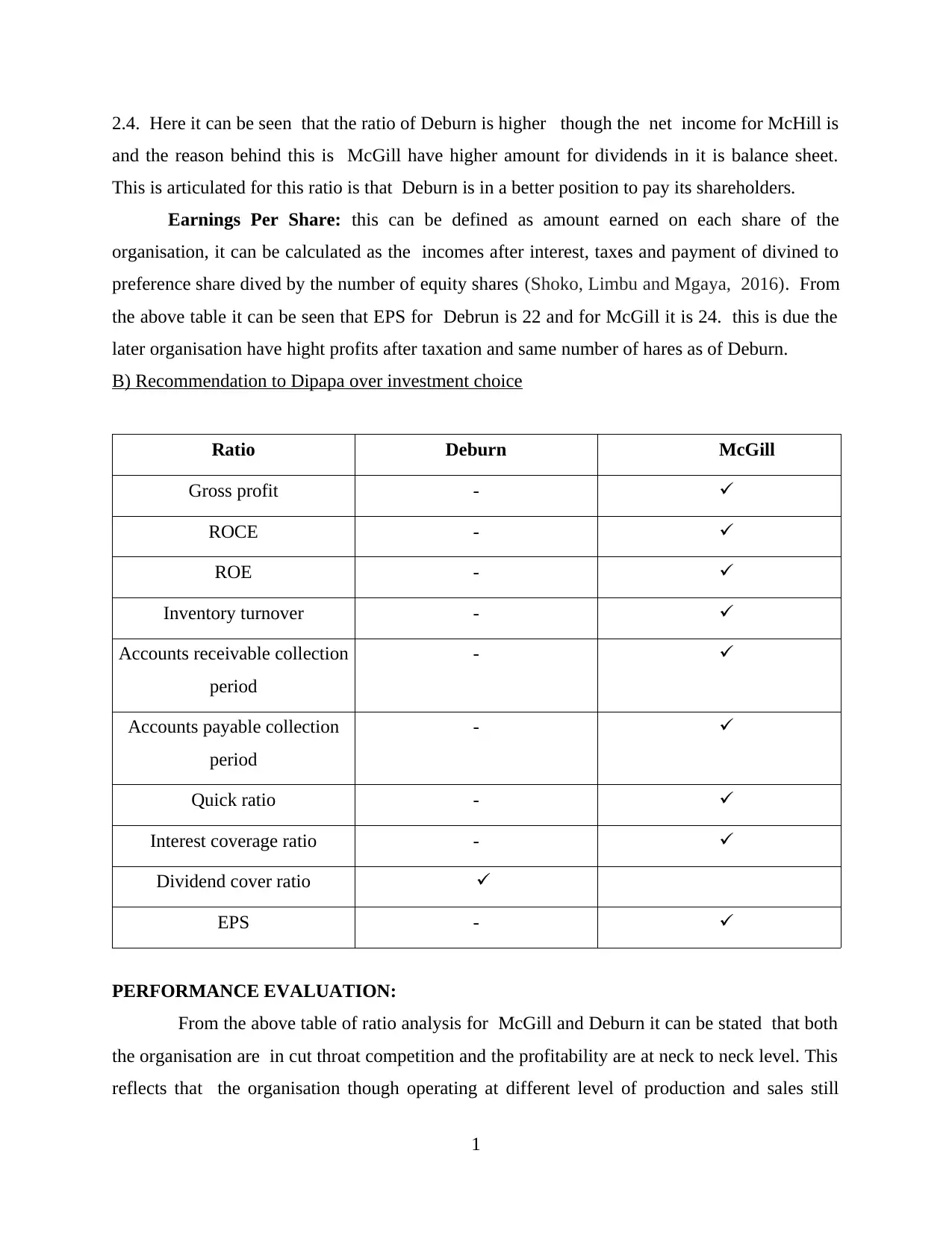
2.4. Here it can be seen that the ratio of Deburn is higher though the net income for McHill is
and the reason behind this is McGill have higher amount for dividends in it is balance sheet.
This is articulated for this ratio is that Deburn is in a better position to pay its shareholders.
Earnings Per Share: this can be defined as amount earned on each share of the
organisation, it can be calculated as the incomes after interest, taxes and payment of divined to
preference share dived by the number of equity shares (Shoko, Limbu and Mgaya, 2016). From
the above table it can be seen that EPS for Debrun is 22 and for McGill it is 24. this is due the
later organisation have hight profits after taxation and same number of hares as of Deburn.
B) Recommendation to Dipapa over investment choice
Ratio Deburn McGill
Gross profit -
ROCE -
ROE -
Inventory turnover -
Accounts receivable collection
period
-
Accounts payable collection
period
-
Quick ratio -
Interest coverage ratio -
Dividend cover ratio
EPS -
PERFORMANCE EVALUATION:
From the above table of ratio analysis for McGill and Deburn it can be stated that both
the organisation are in cut throat competition and the profitability are at neck to neck level. This
reflects that the organisation though operating at different level of production and sales still
1
and the reason behind this is McGill have higher amount for dividends in it is balance sheet.
This is articulated for this ratio is that Deburn is in a better position to pay its shareholders.
Earnings Per Share: this can be defined as amount earned on each share of the
organisation, it can be calculated as the incomes after interest, taxes and payment of divined to
preference share dived by the number of equity shares (Shoko, Limbu and Mgaya, 2016). From
the above table it can be seen that EPS for Debrun is 22 and for McGill it is 24. this is due the
later organisation have hight profits after taxation and same number of hares as of Deburn.
B) Recommendation to Dipapa over investment choice
Ratio Deburn McGill
Gross profit -
ROCE -
ROE -
Inventory turnover -
Accounts receivable collection
period
-
Accounts payable collection
period
-
Quick ratio -
Interest coverage ratio -
Dividend cover ratio
EPS -
PERFORMANCE EVALUATION:
From the above table of ratio analysis for McGill and Deburn it can be stated that both
the organisation are in cut throat competition and the profitability are at neck to neck level. This
reflects that the organisation though operating at different level of production and sales still
1
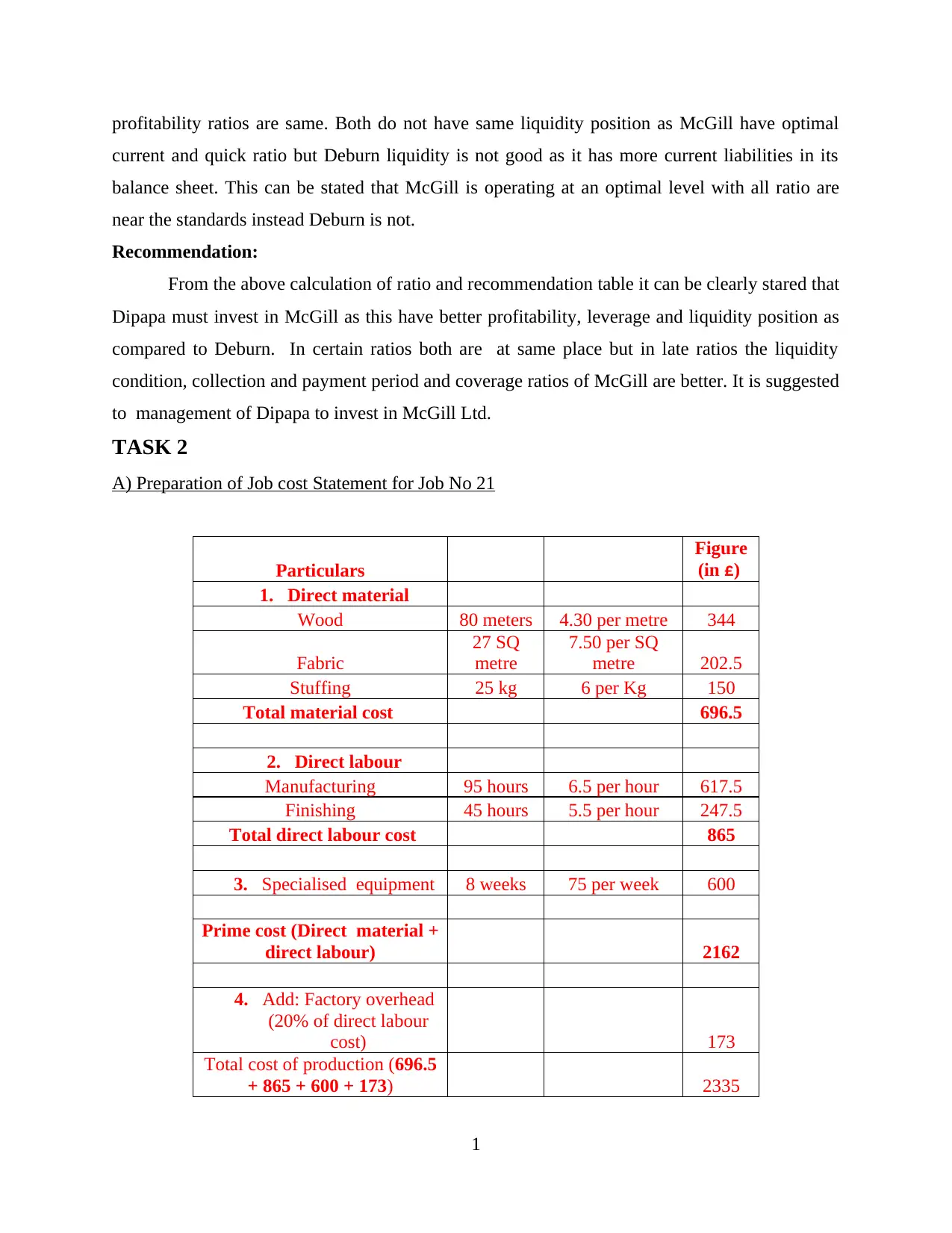
profitability ratios are same. Both do not have same liquidity position as McGill have optimal
current and quick ratio but Deburn liquidity is not good as it has more current liabilities in its
balance sheet. This can be stated that McGill is operating at an optimal level with all ratio are
near the standards instead Deburn is not.
Recommendation:
From the above calculation of ratio and recommendation table it can be clearly stared that
Dipapa must invest in McGill as this have better profitability, leverage and liquidity position as
compared to Deburn. In certain ratios both are at same place but in late ratios the liquidity
condition, collection and payment period and coverage ratios of McGill are better. It is suggested
to management of Dipapa to invest in McGill Ltd.
TASK 2
A) Preparation of Job cost Statement for Job No 21
Particulars
Figure
(in £)
1. Direct material
Wood 80 meters 4.30 per metre 344
Fabric
27 SQ
metre
7.50 per SQ
metre 202.5
Stuffing 25 kg 6 per Kg 150
Total material cost 696.5
2. Direct labour
Manufacturing 95 hours 6.5 per hour 617.5
Finishing 45 hours 5.5 per hour 247.5
Total direct labour cost 865
3. Specialised equipment 8 weeks 75 per week 600
Prime cost (Direct material +
direct labour) 2162
4. Add: Factory overhead
(20% of direct labour
cost) 173
Total cost of production (696.5
+ 865 + 600 + 173) 2335
1
current and quick ratio but Deburn liquidity is not good as it has more current liabilities in its
balance sheet. This can be stated that McGill is operating at an optimal level with all ratio are
near the standards instead Deburn is not.
Recommendation:
From the above calculation of ratio and recommendation table it can be clearly stared that
Dipapa must invest in McGill as this have better profitability, leverage and liquidity position as
compared to Deburn. In certain ratios both are at same place but in late ratios the liquidity
condition, collection and payment period and coverage ratios of McGill are better. It is suggested
to management of Dipapa to invest in McGill Ltd.
TASK 2
A) Preparation of Job cost Statement for Job No 21
Particulars
Figure
(in £)
1. Direct material
Wood 80 meters 4.30 per metre 344
Fabric
27 SQ
metre
7.50 per SQ
metre 202.5
Stuffing 25 kg 6 per Kg 150
Total material cost 696.5
2. Direct labour
Manufacturing 95 hours 6.5 per hour 617.5
Finishing 45 hours 5.5 per hour 247.5
Total direct labour cost 865
3. Specialised equipment 8 weeks 75 per week 600
Prime cost (Direct material +
direct labour) 2162
4. Add: Factory overhead
(20% of direct labour
cost) 173
Total cost of production (696.5
+ 865 + 600 + 173) 2335
1
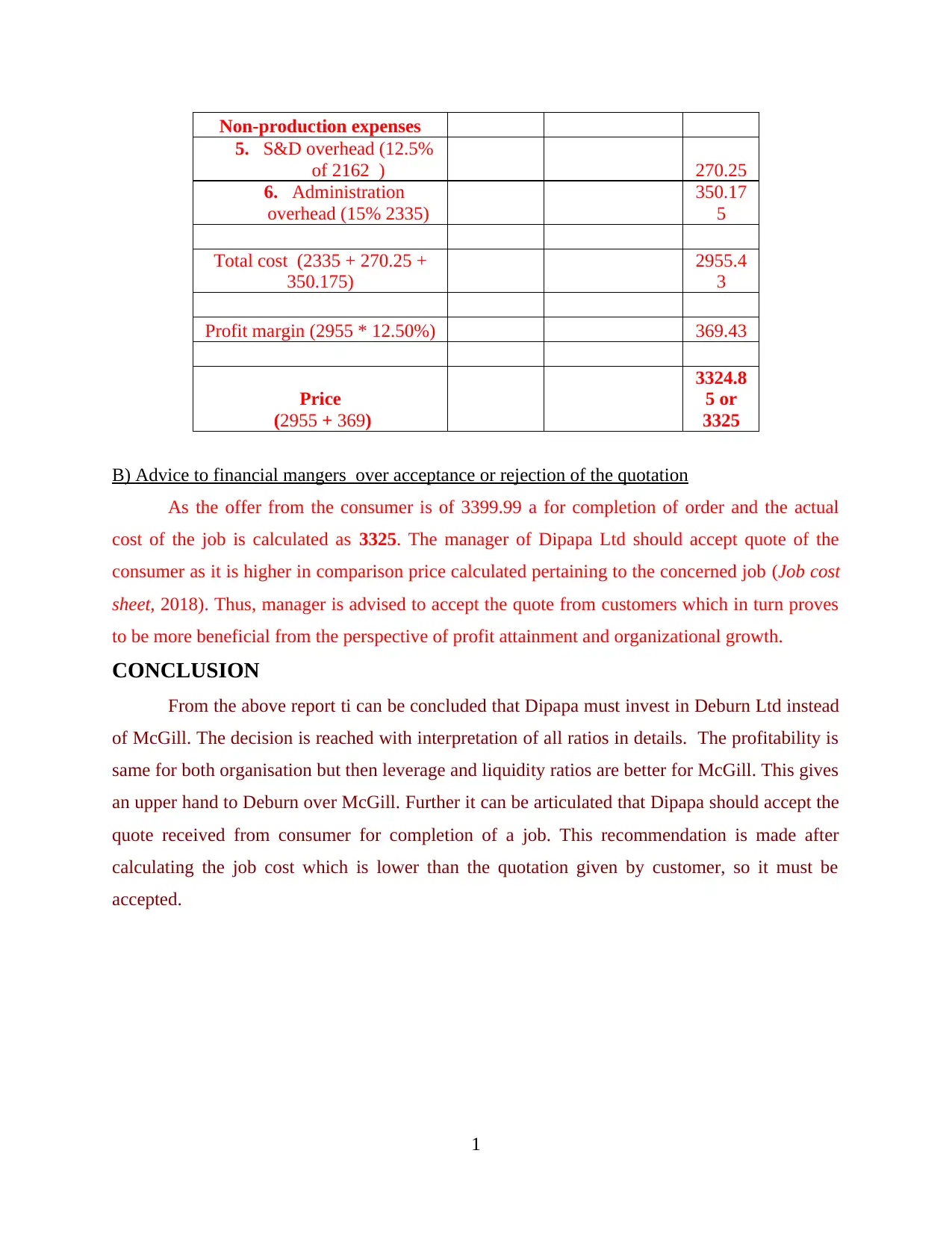
Non-production expenses
5. S&D overhead (12.5%
of 2162 ) 270.25
6. Administration
overhead (15% 2335)
350.17
5
Total cost (2335 + 270.25 +
350.175)
2955.4
3
Profit margin (2955 * 12.50%) 369.43
Price
(2955 + 369)
3324.8
5 or
3325
B) Advice to financial mangers over acceptance or rejection of the quotation
As the offer from the consumer is of 3399.99 a for completion of order and the actual
cost of the job is calculated as 3325. The manager of Dipapa Ltd should accept quote of the
consumer as it is higher in comparison price calculated pertaining to the concerned job (Job cost
sheet, 2018). Thus, manager is advised to accept the quote from customers which in turn proves
to be more beneficial from the perspective of profit attainment and organizational growth.
CONCLUSION
From the above report ti can be concluded that Dipapa must invest in Deburn Ltd instead
of McGill. The decision is reached with interpretation of all ratios in details. The profitability is
same for both organisation but then leverage and liquidity ratios are better for McGill. This gives
an upper hand to Deburn over McGill. Further it can be articulated that Dipapa should accept the
quote received from consumer for completion of a job. This recommendation is made after
calculating the job cost which is lower than the quotation given by customer, so it must be
accepted.
1
5. S&D overhead (12.5%
of 2162 ) 270.25
6. Administration
overhead (15% 2335)
350.17
5
Total cost (2335 + 270.25 +
350.175)
2955.4
3
Profit margin (2955 * 12.50%) 369.43
Price
(2955 + 369)
3324.8
5 or
3325
B) Advice to financial mangers over acceptance or rejection of the quotation
As the offer from the consumer is of 3399.99 a for completion of order and the actual
cost of the job is calculated as 3325. The manager of Dipapa Ltd should accept quote of the
consumer as it is higher in comparison price calculated pertaining to the concerned job (Job cost
sheet, 2018). Thus, manager is advised to accept the quote from customers which in turn proves
to be more beneficial from the perspective of profit attainment and organizational growth.
CONCLUSION
From the above report ti can be concluded that Dipapa must invest in Deburn Ltd instead
of McGill. The decision is reached with interpretation of all ratios in details. The profitability is
same for both organisation but then leverage and liquidity ratios are better for McGill. This gives
an upper hand to Deburn over McGill. Further it can be articulated that Dipapa should accept the
quote received from consumer for completion of a job. This recommendation is made after
calculating the job cost which is lower than the quotation given by customer, so it must be
accepted.
1
Secure Best Marks with AI Grader
Need help grading? Try our AI Grader for instant feedback on your assignments.
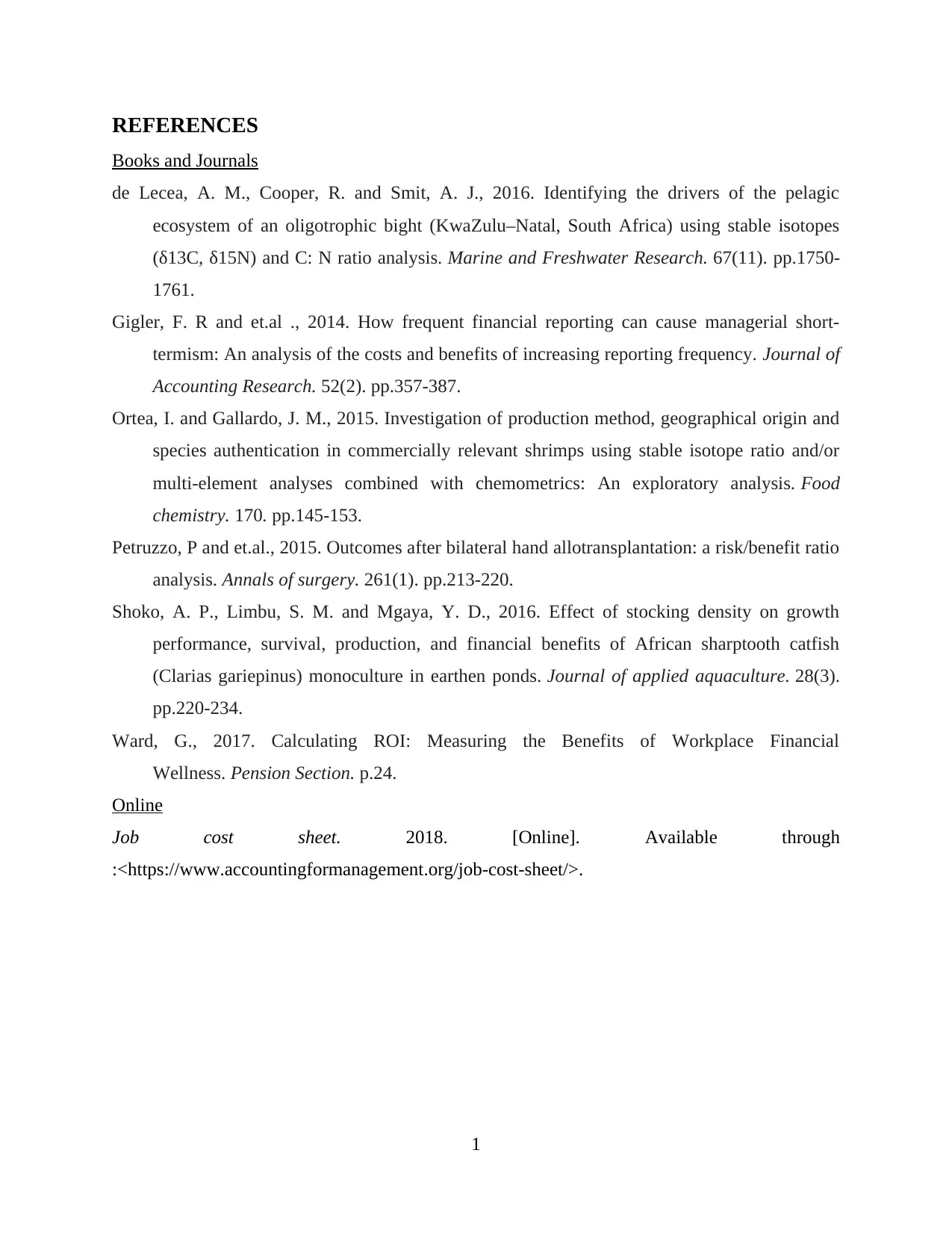
REFERENCES
Books and Journals
de Lecea, A. M., Cooper, R. and Smit, A. J., 2016. Identifying the drivers of the pelagic
ecosystem of an oligotrophic bight (KwaZulu–Natal, South Africa) using stable isotopes
(δ13C, δ15N) and C: N ratio analysis. Marine and Freshwater Research. 67(11). pp.1750-
1761.
Gigler, F. R and et.al ., 2014. How frequent financial reporting can cause managerial short‐
termism: An analysis of the costs and benefits of increasing reporting frequency. Journal of
Accounting Research. 52(2). pp.357-387.
Ortea, I. and Gallardo, J. M., 2015. Investigation of production method, geographical origin and
species authentication in commercially relevant shrimps using stable isotope ratio and/or
multi-element analyses combined with chemometrics: An exploratory analysis. Food
chemistry. 170. pp.145-153.
Petruzzo, P and et.al., 2015. Outcomes after bilateral hand allotransplantation: a risk/benefit ratio
analysis. Annals of surgery. 261(1). pp.213-220.
Shoko, A. P., Limbu, S. M. and Mgaya, Y. D., 2016. Effect of stocking density on growth
performance, survival, production, and financial benefits of African sharptooth catfish
(Clarias gariepinus) monoculture in earthen ponds. Journal of applied aquaculture. 28(3).
pp.220-234.
Ward, G., 2017. Calculating ROI: Measuring the Benefits of Workplace Financial
Wellness. Pension Section. p.24.
Online
Job cost sheet. 2018. [Online]. Available through
:<https://www.accountingformanagement.org/job-cost-sheet/>.
1
Books and Journals
de Lecea, A. M., Cooper, R. and Smit, A. J., 2016. Identifying the drivers of the pelagic
ecosystem of an oligotrophic bight (KwaZulu–Natal, South Africa) using stable isotopes
(δ13C, δ15N) and C: N ratio analysis. Marine and Freshwater Research. 67(11). pp.1750-
1761.
Gigler, F. R and et.al ., 2014. How frequent financial reporting can cause managerial short‐
termism: An analysis of the costs and benefits of increasing reporting frequency. Journal of
Accounting Research. 52(2). pp.357-387.
Ortea, I. and Gallardo, J. M., 2015. Investigation of production method, geographical origin and
species authentication in commercially relevant shrimps using stable isotope ratio and/or
multi-element analyses combined with chemometrics: An exploratory analysis. Food
chemistry. 170. pp.145-153.
Petruzzo, P and et.al., 2015. Outcomes after bilateral hand allotransplantation: a risk/benefit ratio
analysis. Annals of surgery. 261(1). pp.213-220.
Shoko, A. P., Limbu, S. M. and Mgaya, Y. D., 2016. Effect of stocking density on growth
performance, survival, production, and financial benefits of African sharptooth catfish
(Clarias gariepinus) monoculture in earthen ponds. Journal of applied aquaculture. 28(3).
pp.220-234.
Ward, G., 2017. Calculating ROI: Measuring the Benefits of Workplace Financial
Wellness. Pension Section. p.24.
Online
Job cost sheet. 2018. [Online]. Available through
:<https://www.accountingformanagement.org/job-cost-sheet/>.
1
1 out of 11
Related Documents
Your All-in-One AI-Powered Toolkit for Academic Success.
+13062052269
info@desklib.com
Available 24*7 on WhatsApp / Email
![[object Object]](/_next/static/media/star-bottom.7253800d.svg)
Unlock your academic potential
© 2024 | Zucol Services PVT LTD | All rights reserved.





